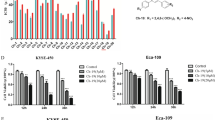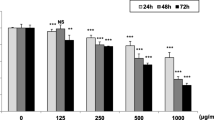Abstract
Esophageal cancer is one of the malignant cancers with a low 5-year survival rate. Licochalcone (LC) H, a chemically synthesized substance, is a regioisomer of LCC extracted from licorice. The purpose of this study was to determine whether LCH might have anticancer effect on human esophageal squamous cell carcinoma (ESCC) cell lines via apoptosis signaling pathway. After 48 h of treatment, IC50 of LCH in KYSE 30, KYSE 70, KYSE 410, KYSE 450, and KYSE 510 cells were 15, 14, 18, 15, and 16 μM, respectively. This study demonstrated that LCH potently suppressed proliferation of ESCC cells in a concentration- and time-dependent manner. LCH triggered G2/M-phase arrest by modulating expression levels of cdc2, cyclin B1, p21, and p27. LCH also induced apoptosis of ESCC cells through reactive oxygen species-mediated endoplasmic reticulum (ER) stress via JNK/p38 activation pathways. The anticancer effect of LCH was associated with ER stress and mitochondrial dysfunction. It also affected protein levels of Mcl-1, tBid, Bax, Bcl-2, cytochrome c, Apaf-1, PARP, cleaved-PARP, and ER stress-related proteins (GRP78 and CHOP). Our findings provide the first demonstration that LCH has anticancer effect on ESCC. Thus, LCH might have potential for preventing and/or treating human ESCC.






Similar content being viewed by others
References
Kashyap, M. K., & Abdel-Rahman, O. (2018). Expression, regulation and targeting of receptor tyrosine kinases in esophageal squamous cell carcinoma. Molecular Cancer, 17, 54.
Barbhuiya, M. A., Kashyap, M. K., Puttamallesh, V. N., Kumar, R. V., Wu, X., & Pandey, A., et al. (2018). Identification of spleen tyrosine kinase as a potential therapeutic target for esophageal squamous cell carcinoma using reverse phase protein arrays. Oncotarget, 9, 18422–34.
Lin, D. C., Hao, J. J., Nagata, Y., Xu, L., Shang, L., & Meng, X., et al. (2014). Genomic and molecular characterization of esophageal squamous cell carcinoma. Nature Genetics, 46, 467–73.
Ohashi, S., Miyamoto, S., Kikuchi, O., Goto, T., Amanuma, Y., & Muto, M. (2015). Recent advances from basic and clinical studies of esophageal squamous cell carcinoma. Gastroenterology, 149, 1700–15.
Dandawate, P. R., Subramaniam, D., Jensen, R. A., & Anant, S. (2016). Targeting cancer stem cells and signaling pathways by phytochemicals: novel approach for breast cancer therapy. Seminar in Cancer Biology, 40-41, 192–208.
Dastagir, G., & Rizvi, M. A. (2016). Review - Glycyrrhiza glabra L. (Liquorice). Pakistan Journal of Pharmaceutical Sciences, 29, 1727–33.
Kang, T. H., Yoon, G., Kang, I. A., Oh, H. N., Chae, J. I., & Shim, J. H. (2017). Natural compound licochalcone B induced extrinsic and intrinsic apoptosis in human skin melanoma (A375) and squamous cell carcinoma (A431) cells. Phytotherapy Research, 31, 1858–67.
Saitoh, T., & Shibata, S. (1975). New type chalcones from licorice root. Tetrahedron Letters, 16, 4461–2.
Kajiyama, K., Demizu, S., Hiraga, Y., Kinoshita, K., Koyama, K., & Takahashi, K., et al. (1992). Two prenylated retrochalcones from Glycyrrhiza inflata. Phytochemistry, 31, 3229–32.
Yoon, G., Jung, Y. D., & Cheon, S. H. (2005). Cytotoxic allyl retrochalcone from the roots of Glycyrrhiza inflata. Chemical and Pharmaceutical Bulletin (Tokyo), 53, 694–5.
Dao, T. T., Nguyen, P. H., Lee, H. S., Kim, E., Park, J., & Lim, S. I., et al. (2011). Chalcones as novel influenza A (H1N1) neuraminidase inhibitors from Glycyrrhiza inflata. Bioorganic & Medicinal Chemistry Letters, 21, 294–8.
Yoon, G., Lee, W., Kim, S. N., & Cheon, S. H. (2009). Inhibitory effect of chalcones and their derivatives from Glycyrrhiza inflata on protein tyrosine phosphatase 1B. Bioorganic & Medicinal Chemistry Letters, 19, 5155–7.
Wang, Z., Cao, Y., Paudel, S., Yoon, G., & Cheon, S. H. (2013). Concise synthesis of licochalcone C and its regioisomer, licochalcone H. Archives of Pharmacal Research, 36, 1432–6.
Lin, C. L., Lee, C. H., Chen, C. M., Cheng, C. W., Chen, P. N., & Ying, T. H., et al. (2018). Protodioscin induces apoptosis through ROS-mediated endoplasmic reticulum stress via the JNK/p38 activation pathways in human cervical cancer cells. Cellular Physiology and Biochemistry, 46, 322–34.
Cuenda, A., & Rousseau, S. (2007). p38 MAP-kinases pathway regulation, function and role in human diseases. Biochimica et Biophysica Acta, 1773, 1358–75.
Lim, S., & Kaldis, P. (2013). Cdks, cyclins and CKIs: roles beyond cell cycle regulation. Development, 140, 3079–93.
Redza-Dutordoir, M., & Averill-Bates, D. A. (2016). Activation of apoptosis signalling pathways by reactive oxygen species. Biochimica et Biophysica Acta, 1863, 2977–92.
Liu, C., Sun, H. N., Luo, Y. H., Piao, X. J., Wu, D. D., & Meng, L. Q., et al. (2017). Cryptotanshinone induces ROS-mediated apoptosis in human gastric cancer cells. Oncotarget, 8, 115398–412.
Jiang, X., Jiang, H., Shen, Z., & Wang, X. (2014). Activation of mitochondrial protease OMA1 by Bax and Bak promotes cytochrome c release during apoptosis. Proceedings of the Nationall Academy of Sciences of United States of America, 111, 14782–7.
Hensley, P., Mishra, M., & Kyprianou, N. (2013). Targeting caspases in cancer therapeutics. Biological Chemistry, 394, 831–43.
Kam, T. Y., Kountouri, M., Roth, A., Frossard, J. L., Huber, O., & Monig, S., et al. (2018). Endoscopic resection with adjuvant chemo-radiotherapy for superficial esophageal squamous cell carcinoma: a critical review. Critical Reviews in Oncology Hematology, 124, 61–5.
Higuchi, K., Koizumi, W., Tanabe, S., Sasaki, T., Katada, C., & Azuma, M., et al. (2009). Current management of esophageal squamous-cell carcinoma in Japan and other countries. Gastrointestinal Cancer Research, 3, 153–61.
Haj Mohammad, N., Hulshof, M. C., Bergman, J. J., Geijsen, D., Wilmink, J. W., & van Berge Henegouwen, M. I., et al. (2014). Acute toxicity of definitive chemoradiation in patients with inoperable or irresectable esophageal carcinoma. BMC Cancer, 14, 56.
Oh, H., Yoon, G., Shin, J. C., Park, S. M., Cho, S. S., & Cho, J. H., et al. (2016). Licochalcone B induces apoptosis of human oral squamous cell carcinoma through the extrinsic- and intrinsic-signaling pathways. International Journal of Oncology, 48, 1749–57.
Lee, C. K., Son, S. H., Park, K. K., Park, J. H., Lim, S. S., & Kim, S. H., et al. (2008). Licochalcone A inhibits the growth of colon carcinoma and attenuates cisplatin-induced toxicity without a loss of chemotherapeutic efficacy in mice. Basic & Clinical Pharmacology Toxicology, 103, 48–54.
Franceschelli, S., Pesce, M., Vinciguerra, I., Ferrone, A., Riccioni, G., & Patruno, A., et al. (2011). Licocalchone-C extracted from Glycyrrhiza glabra inhibits lipopolysaccharide-interferon-gamma inflammation by improving antioxidant conditions and regulating inducible nitric oxide synthase expression. Molecules, 16, 5720–34.
Jutooru, I., Guthrie, A. S., Chadalapaka, G., Pathi, S., Kim, K., & Burghardt, R., et al. (2014). Mechanism of action of phenethylisothiocyanate and other reactive oxygen species-inducing anticancer agents. Molecular and Cellular Biology, 34, 2382–95.
Chen, L., Xu, S., Liu, L., Wen, X., Xu, Y., & Chen, J., et al. (2014). Cab45S inhibits the ER stress-induced IRE1-JNK pathway and apoptosis via GRP78/BiP. Cell Death & Disease, 5, e1219.
Dalton, L. E., Clarke, H. J., Knight, J., Lawson, M. H., Wason, J., & Lomas, D. A., et al. (2013). The endoplasmic reticulum stress marker CHOP predicts survival in malignant mesothelioma. British Journal of Cancer, 108, 1340–7.
Yamaguchi, H., & Wang, H. G. (2004). CHOP is involved in endoplasmic reticulum stress-induced apoptosis by enhancing DR5 expression in human carcinoma cells. Journal of Biological Chemistry, 279, 45495–502.
Zheng, Y. Z., Cao, Z. G., Hu, X., & Shao, Z. M. (2014). The endoplasmic reticulum stress markers GRP78 and CHOP predict disease-free survival and responsiveness to chemotherapy in breast cancer. Breast Cancer and Research Treatment, 145, 349–58.
Czabotar, P. E., Lessene, G., Strasser, A., & Adams, J. M. (2014). Control of apoptosis by the BCL-2 protein family: implications for physiology and therapy. Nature Reviews Molecular Cell Biology, 15, 49–63.
Li-Weber, M. (2015). Molecular mechanisms and anti-cancer aspects of the medicinal phytochemicals rocaglamides (=flavaglines). International Journal of Cancer, 137, 1791–9.
Zhang, X. H., Zou, Z. Q., Xu, C. W., Shen, Y. Z., & Li, D. (2011). Myricetin induces G2/M phase arrest in HepG2 cells by inhibiting the activity of the cyclin B/Cdc2 complex. Molecular Medicine Reports, 4, 273–7.
Johnson, G. L., & Lapadat, R. (2002). Mitogen-activated protein kinase pathways mediated by ERK, JNK, and p38 protein kinases. Science, 298, 1911–2.
Yuan, L., Wang, J., Xiao, H., Wu, W., Wang, Y., & Liu, X. (2013). MAPK signaling pathways regulate mitochondrial-mediated apoptosis induced by isoorientin in human hepatoblastoma cancer cells. Food and Chemical Toxicology, 53, 62–8.
Acknowledgements
This research was supported by Basic Science Research program through the National Research Foundation Korea, funded by the Ministry of Education, Science and Technology (2019R1A2C1005899). This work was carried out with the support of “Cooperative Research Program for Agriculture Science & Technology Development (Project No. PJ013842)” Rural Development Administration, Republic of Korea. This research was studied by research funds of MNU Innovative programs for University in 2019 (basic construction for convergence research).
Author information
Authors and Affiliations
Corresponding author
Ethics declarations
Conflict of Interest
The authors declare that they have no conflict of interest.
Additional information
Publisher’s note Springer Nature remains neutral with regard to jurisdictional claims in published maps and institutional affiliations.
Rights and permissions
About this article
Cite this article
Kwak, AW., Cho, SS., Yoon, G. et al. Licochalcone H Synthesized by Modifying Structure of Licochalcone C Extracted from Glycyrrhiza inflata Induces Apoptosis of Esophageal Squamous Cell Carcinoma Cells. Cell Biochem Biophys 78, 65–76 (2020). https://doi.org/10.1007/s12013-019-00892-3
Received:
Accepted:
Published:
Issue Date:
DOI: https://doi.org/10.1007/s12013-019-00892-3




